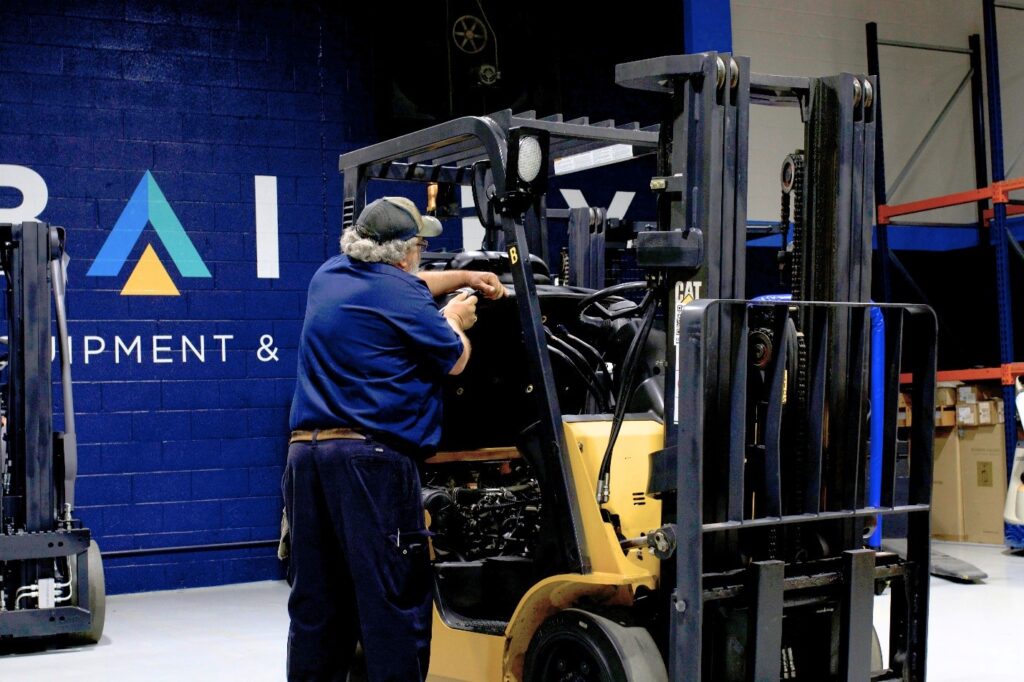Forklift Maintenance Guide: Your Ultimate Resource for Safety and Efficiency
The Importance of Regular Forklift Maintenance
Consistent maintenance is the single most effective way to extend your forklift’s lifespan and avoid costly, unexpected downtime. A proactive approach helps identify minor issues before they become major repairs. The benefits include:
- Enhanced Safety: A well-maintained forklift is a safe forklift. Regular checks help prevent accidents caused by equipment failure.
- Reduced Downtime: Scheduled maintenance minimizes unplanned downtime, keeping your productivity on track.
- Lower Repair Costs: Addressing small problems early is far more cost-effective than dealing with major component failures.
- Improved Performance: Proper care ensures your forklift operates at peak efficiency, saving on fuel and energy costs.
- Extended Equipment Lifespan: A consistent maintenance schedule protects your investment and maximizes the operational life of your fleet.
Your Daily Forklift Maintenance Checklist

Pre-Operation Inspection (Engine Off)
-
01
Tires & Wheels:
Look for any visible damage such as cuts, gouges, missing chunks, embedded foreign objects, or excessive wear patterns. Ensure wheels are securely attached and free from damage. -
02
Forks & Mast:
Carefully inspect the forks for any signs of cracks, bends, distortion, or excessive wear at the heel. Check the mast assembly for structural integrity, ensuring that rails are straight, rollers move freely, and chains are securely attached, properly tensioned, and show no signs of rust or broken links. -
03
Fluid Levels:
Verify that all essential fluid levels are within the recommended range. This includes checking engine oil, hydraulic fluid, coolant, and fuel levels. Low fluid levels can indicate leaks or pending issues. -
04
Hoses & Belts:
Conduct a visual inspection of all hydraulic hoses, coolant hoses, and drive belts. Look for any signs of leaks, cracks, fraying, bulges, or loose connections. Belts should have appropriate tension. -
05
Battery:
For electric forklifts, check the battery's charge level. Ensure terminals are clean, connections are secure, and there are no signs of corrosion or leakage from the battery cells. Confirm the battery restraint system is functioning. -
06
Safety Equipment:
Confirm that all safety equipment is present and in good working order. This includes inspecting the seatbelt for cuts or fraying, the overhead guard for damage or deformation, and ensuring all warning decals and capacity plates are legible and attached. -
07
General Condition:
Scan the entire forklift for any loose components, missing hardware, or visible damage to the chassis, counterweight, and body panels. Report any unusual findings immediately.
Operational Inspection (Engine On)
-
01
Brakes:
Test both the service brake and parking brake to ensure they are functioning correctly. The service brake should bring the forklift to a smooth and controlled stop, while the parking brake should hold the vehicle securely in place when engaged. Any signs of reduced braking performance, such as a spongy pedal or unusual noises, should be reported immediately. -
02
Steering:
Check that the steering is smooth, responsive, and free of excessive play. The steering wheel should not feel stiff or unresponsive, and there should be no unusual vibrations or noises while turning. Proper steering is essential for maintaining control of the forklift during operation. -
03
Lifting & Tilting:
Operate the lift and tilt mechanisms to confirm they move smoothly and without hesitation or unusual noises. Ensure the forks lift and lower evenly, and that tilting functions allow for precise control. Any jerky movements or grinding sounds should be inspected further before use. -
04
Horn & Lights:
Test the horn to ensure it produces a loud and clear sound, as it is vital for alerting others in the work area. Check the headlights, taillights, and any warning or indicator lights to confirm they are functioning properly. Faulty lights can compromise visibility and safety in low-light environments. -
05
Gauges & Instruments:
Inspect all dashboard gauges and instruments, including the fuel gauge, battery level indicator, and any warning lights, to ensure they are providing accurate and reliable readings. Malfunctioning gauges can lead to undetected issues, which may pose a safety risk.
Key Preventative Maintenance Tasks
Beyond daily checks, a planned maintenance schedule is essential to extend your forklift lifespan. These tasks should be performed by a qualified technician at regular intervals based on manufacturer recommendations and operating hours.
- Oil and Filter Changes: Just like a car, forklifts need regular engine and hydraulic oil changes to keep internal components lubricated and clean.
- Tire Inspection: Regularly inspect tires for wear and tear.
- Brake System Service: A technician should inspect brake pads, drums, and hydraulic lines to ensure optimal stopping power.
- Mast and Chain Maintenance: Chains require regular cleaning, lubrication, and tension adjustments to prevent stretching and failure.
- Cooling System Flush: Flushing the radiator and replacing the coolant prevents overheating and protects the engine.

Common Forklift Repair Tips & Troubleshooting
*Important: These are general forklift repair tips. Complex diagnostics and repairs should always be handled by trained professionals. Attempting to fix major issues without proper training can lead to further damage or serious safety hazards.
-
Problem: The mast won't lift or lower properly.Possible Cause: This often points to low hydraulic fluid or a potential issue with the hydraulic pump or lift cylinders.
-
Problem: The forklift won't start.Possible Cause: For electric models, this could be a dead or disconnected battery. For internal combustion models, check fuel levels, battery connections, and ignition components.
-
Problem: Steering is difficult or unresponsive.Possible Cause: This issue can be attributed to low steering fluid, a worn steering linkage, or tire pressure problems.



Why Bailey?
Bailey is your trusted partner for material handling solutions across Tennessee, Kentucky, Georgia, Virginia, and across the nation. With decades of hands-on experience, technical expertise, and a deep understanding of regional business needs, we help companies optimize operations, improve efficiency, and reduce downtime.
Our team delivers tailored solutions that match your facility, workflows, and goals. From warehouse equipment to automation and service, we provide reliable, high-quality solutions that support long-term success. As a family- and women-owned business, we prioritize relationships, integrity, and customer satisfaction in every interaction.
Sustainability is more than a goal—it’s a standard at Bailey. We operate responsibly, continuously seeking ways to improve environmental impact while helping your business thrive. With fast, dependable support and a full-service approach, Bailey is the partner businesses choose when performance matters.
Whether you need a comprehensive planned maintenance program, emergency repairs, or high-quality parts, our team of full-service technicians is ready to help.

Ready to Get Started?
Our Insights
-
07.12.2024
Warehouse Racking Success | Case Study
Case Studies, One Material Handling Solution -
 05.07.2024
05.07.2024Bailey Sponsors Walk Bike Nashville’s 20th Annual Tour de Nash
Life at Bailey, Sustainability -
 07.24.2023
07.24.2023Bailey Wins 2023 Governor’s Environmental Stewardship Award in Sustainable Performance
Sustainability


